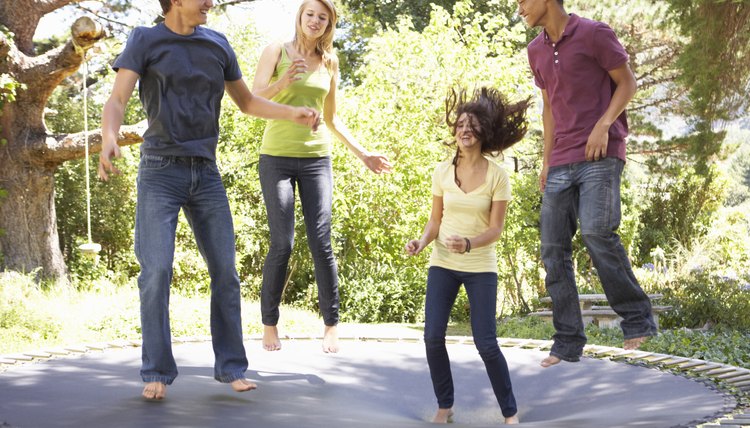The Difference Between a Rebounder & Trampoline

Rebounders -- sometimes just called mini trampolines -- and trampolines use the same basic jumping motions and are made from similar materials, but are used for entirely different purposes. A trampoline is a recreational device that you can use for exercise, while rebounders are designed for specific exercise routines such as rebounding aerobics.
Workout Goals
The large size of a trampoline makes it ideal for tumbling workouts and practicing stunts such as flips and handsprings. Rebounders, by contrast, don't allow space for practicing stunts. Instead, they're primarily used for aerobic exercise routines. You might jump up and down on your rebounder, practice jumping on and off in a modified box jump, or incorporate elements of aerobics by holding dumbbells as you run in place on the rebounder.
Size and Function
A rebounder is both narrower and lower to the ground than a standard trampoline. Rebounders vary in size, but are usually about two to four feet in diameter and only elevated one to two feet off the ground. Trampolines are usually three to four feet above the ground, and can be six or more feet wide. This significant size difference makes rebounders ideal for travel and gym-based workout classes. Standard trampolines, however, stay in one place.
Safety
Both rebounders and trampolines pose a risk of head injuries, and the American Academy of Pediatrics advises that children should not play with either. However, rebounders are generally safer because they are lower to the ground and provide less room for dangerous tricks such as flips, decreasing the risk of a fall.
Customization
Both rebounders and trampolines are customizable, but rebounder accessories are designed for specific workouts. For example, you can buy a stabilizer bar that improves the stability of your rebounder while offering you a bar to grip during aerobic workouts. Trampoline accessories are typically designed to make the device safer, and include items such as nets and spring pads.
References
Writer Bio
Van Thompson is an attorney and writer. A former martial arts instructor, he holds bachelor's degrees in music and computer science from Westchester University, and a juris doctor from Georgia State University. He is the recipient of numerous writing awards, including a 2009 CALI Legal Writing Award.
